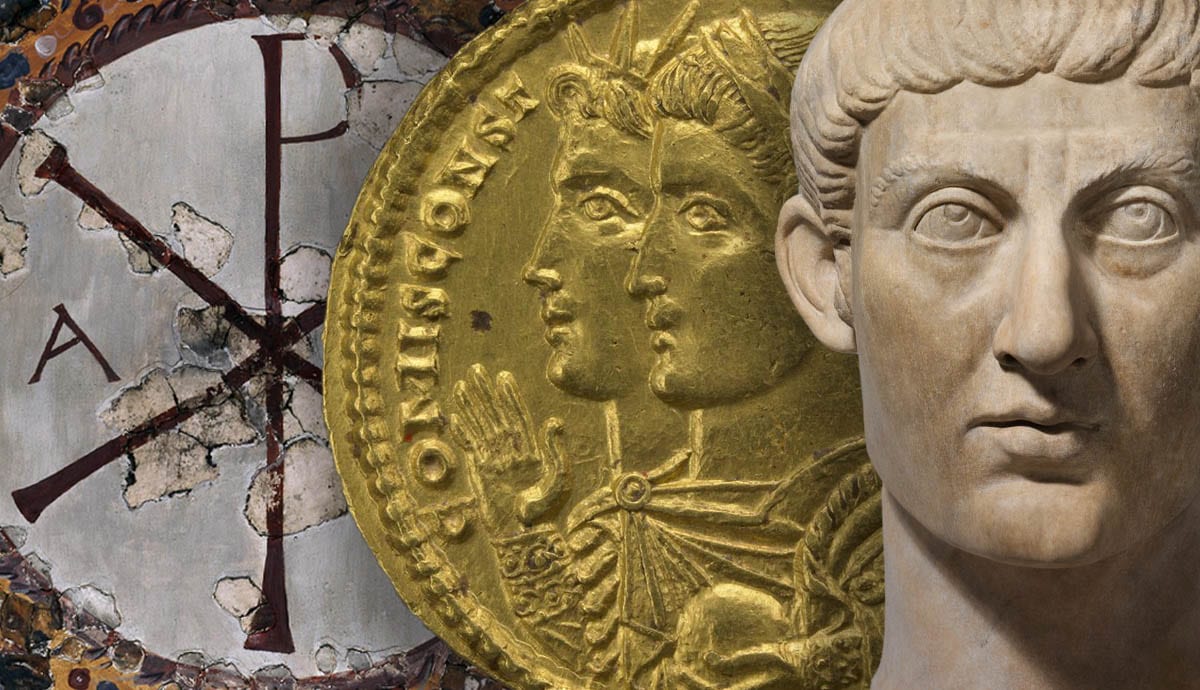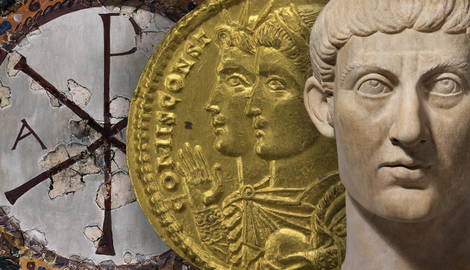
Constantine the Great was one of Rome’s most effective rulers. He is also one of the most important people in European history because his rule would inevitably lead to an extremely powerful Roman Catholic Church. Although his support of Christianity would change the lives of millions, many historians have doubted the sincerity of his beliefs. Why do so many people still question Constantine’s true faith and devotion to the Christian religion, and are they right to do so?
Constantine The Great’s Foundation Myth

In AD 312, Constantine the Great would fight a major battle at the Milvian bridge against his rival Maxentius. Many years later, the Christian Bishop Eusebius would claim that the emperor had told him he had had a vision of the Christian cross above the sun, just before the battle. Underneath the cross were the words “In this sign conquer.” In a dream that same night, Jesus supposedly reaffirmed the message to the emperor.
There are several different versions of this story, but in one version his troops were subsequently ordered to paint the Chi-Rho, a Christian symbol representing the first two letters of Jesus’ name in Greek, upon their shields.
Most modern people are naturally incredulous about visions and miracles, so it is no surprise that most people dismiss this story. Others have argued it is possible that Constantine the Great either had a genuine religious experience or that he saw something which he interpreted as being a religious omen. Many people have speculated that Constantine saw a rare natural phenomenon such as a solar halo.
Whether there is any truth in the story that Constantine had a vision, in the years immediately after Constantine’s victory he appeared to promote himself not as a Christian but as a devotee of the sun god Sol Invictus.
Constantine And Sol Invictus

After AD 312, Constantine the Great would immediately halt the persecution of the Christians, and throughout his reign, he would favor Christians both financially and politically. Many fantastic churches were built during his reign, and some pagan temples were limited.
Despite this, it is not obvious that Emperor Constantine was a very committed Christian, and he would continue to venerate the sun god, Sol Invictus, for most of the first half of his reign.
It was fairly common for Roman emperors to pick a favorite god to identify with in their iconography and Sol Invictus, which means the unconquerable sun was a commonly worshipped solar deity by the time Constantine the Great was emperor.
As late as AD 324, coins depicting the sun god were still being minted, twelve years after his supposed conversion! We even have a piece of writing praising Constantine, which claims that the emperor had had a vision of the sun god Apollo guaranteeing him his thirty-year reign. It was a far cry from Eusebius’ version of events.
As Constantine’s rule went on, his use of solar imagery began to peter out in favor of Christian symbols. He was also extremely supportive of the church from the get-go. Constantine would be baptized just before his death, although late baptisms were common in the ancient world, so it tells us nothing about when he actually converted.
Some speculate that his supposed Christian conversion was the invention of propaganda and a calculated political move. Others that he simply converted later in life. How is the best way to make sense of Constantine’s confusing brand of Christianity?
Religious Revolution

The fact of the matter is, the Roman religious revolution preceded Constantine the Great’s rule, and it was not primarily about Christianity.
Historians’ estimates for the number of Christians during Constantine’s reign vary, but they tend to hover between less than 5% to 10% of the population at the most. The Christians up to this point had been a heavily persecuted group, particularly under Emperor Diocletian. If Constantine’s support of the Christian religion was a pragmatic choice, it cannot have been because Christianity was suddenly the largest religion.
It is popularly believed that Christianity spread primarily amongst the poor, the enslaved, and women first before it caught on with the Roman aristocracy. Jesus’ belief that the downtrodden should be cared for was part of its appeal to various groups of disenfranchised people.
On the other hand, while the Christian religion was probably not yet massive, mystery cults and foreign religions were replacing traditional pantheism with lightning speed.
This was due in part to a philosophical movement called Neoplatonism. From the 3rd century onwards, this school of philosophy basically went unchallenged and supplanted all others. Traditional philosophical education for the aristocratic population of the late Roman Empire would often entail studying at the feet of one of the many Neoplatonist philosophers.
This school is very important for understanding late Roman culture and religion. Its system of philosophy taught that, even if there are other Godlike beings, there is primarily one single all-encompassing ineffable Godhead, which is connected to the divine intellect. They were also concerned with the status of the soul of man in a divine hierarchy. These ideas were, in effect, a religious interpretation of Plato.
Some of the earliest examples of Constantinian propaganda actually make reference to this abstract “Divine mind” popular in late Roman philosophy.

This influential philosophical idea was either reflected or influenced by the growth of ever more philosophical foreign religions, which were quite different from traditional Roman Pantheism. Popular foreign imports tended to be more philosophical, have a more abstract conception of God, and often had a “salvation of the soul” narrative at their heart.
Mithraism, synonymous with sun worship, was one of these imports, and Christianity was another. An early church writer, Justin the Martyr actually complained that Mithraism and Christianity were suspiciously similar. The spread and influence of these new religions were slow to grow, but by the 4th century, ideas about God, or the gods, had changed quite a bit.
The belief in one all-important and ineffable supreme deity, which may or may not have many different lower manifestations, had a massive impact on popular religion. Solar deities were one manifestation of this. In the 3rd century, two emperors, Elagabalus and Aurelian, had already aligned themselves with the different versions of the sun god in their propaganda.
This trend would continue for quite some time after Emperor Constantine’s death, although Christianity would ultimately prove to be the winner. In one particularly famous example from the late 4th century, the bishop St. Augustine was a devotee of Manichaeism, a form of Gnosticism from ancient Persia, before he became a Christian bishop.
Late pagan thinkers after Constantine the Great including Emperor Julian and the philosopher Proclus would continue to privilege the sun as the highest expression of the divine source. Thoughtful, mystical, quasi-monotheistic religions were on the rise.
Jesus, Christian Religion, And Solar Imagery

Conflating the Christian religion with the worship of the sun was probably not yet controversial. The Roman belief system was syncretic; one god worshipped by one group was believed to have many different manifestations. For example, the Greek god Hermes was identified with the Egyptian god Thoth and the British water god Sulis with Minerva.
The early church writer Tertullian mentions many people believed Christians were sun worshippers because of some of their behaviors. Jesus would be connected with the sun again after Constantine the Great’s death. St. Augustine mentions that members of the Manichaean religious sect were still confusing Jesus with the physical sun. Even in the 5th century, Pope Leo the Great would complain that some Christians were still bowing in homage to the sun, just as pagans did.
There is a strong possibility that Constantine’s so-called “wavering” between the sun god and Christ was actually a widely accepted form of syncretism. Even better, by being vague and non-specific, Constantine could promote himself to a broad audience. A multi-faceted religious front was likely to have appealed to many people, and the use of solar symbolism would have been a safe bet.

Popular religion was most likely a far cry from the prescriptive form of Christianity which is steeped in theological debate and reliant on scripture. Ordinary people were still choosing from a mixed bag of religious symbolism.
A look at the Greek magical papyri from Roman Egypt reveals a series of spells and incantations dedicated to figures from Christian and Jewish mythology, who are mentioned in the same context as Apollo or Zeus. Apollo or Helios, and Yahweh appear to be synonymous in some of these writings.
It is possible in his later years, after a lot more contact with important Christian bishops, that Constantine the Great adopted a more straightforwardly orthodox belief system. He convened the Council of Nicaea in 325, which allowed the Church to lay out their ideas in more concrete terms, and it’s very likely that he would have been enormously influenced by this gathering. Notably, it is after this date that he no longer promoted Sol Invictus.
Constantine’s defeat of his co-emperor Licinius around this date may also have contributed to his promotion of a stricter Christian religion, rather than a syncretic monotheism.
Constantine The Great’s Faith

Was Constantine the Great a real Christian? It seems very likely that he was, although we will probably never know for sure. His confusing religious iconography only seems unusual when it is taken out of the context of his time.
The use of Sol Invictus as a stand-in for broadly monotheistic imagery may have benefitted Constantine’s image, but it may also have been part of his original understanding of Christian religion. By the end of his reign, his Christian family members as well as many members of his court may have pushed him towards an orthodox form of Christianity, or he may have felt secure enough as sole ruler to promote himself as definitively Christian.
With the public acceptance of Christianity, church attendance would expand massively and the emperors that followed Constantine the Great would be less ambiguous about their faith.










